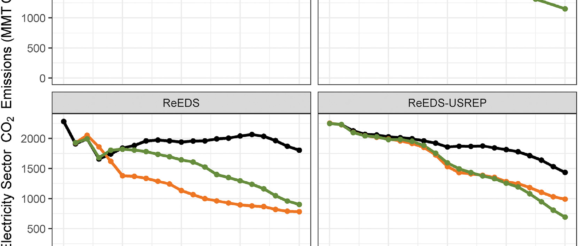U.S. Energy Models Compare Technology Innovation with CO2 Policy

U.S. Energy Models Compare Technology Innovation with CO2 Policy
The impact of technology innovation, fuel prices, and a carbon dioxide (CO2) emissions reduction policy on the electric power and end-use sectors was analyzed by comparing results from four U.S. energy-economic models through the year 2050. The models included an economy-wide model (ReEDS-USREP), two partial equilibrium models with a full energy sector (EPSA-NEMS, GCAM-USA), and an electricity sector-only model (ReEDS). These models differ in multiple ways and provide unique perspectives on the potential impact of each factor of interest on CO2 emissions and energy supply and demand.
The study focused on the following primary questions –
- How are technology choice, electricity price and CO2 emissions affected by natural gas price projections and technology innovation?
- How are the electricity sector emissions and fuel mix with technology innovation impacted by an electricity sector CO2 policy?
- How much do the answers to the previous questions depend on model architecture and assumptions?
Eight different scenarios were run with each model to understand and answer the above questions. These scenarios combined high and low natural gas prices with high and low technology innovation, with and without a CO2 policy. To compare across models, output variables that were most relevant for analyzing the evolution of the energy sector in these scenarios were selected. These include: electricity generation, fossil fuel CO2 emissions by the power sector, wholesale power prices, and energy consumption by end-use sectors.
The study found several results in common across most or all of the models examined, including the following:
- Technology innovation has the potential to achieve CO2 reduction goals in the absence of a CO2 policy, regardless of the assumptions about natural gas prices.
- Technology innovation can achieve a generation mix with similar CO2 emissions as a CO2 policy but with a smaller impact on electricity prices.
- Higher natural gas prices are likely to increase the amount of renewable generation that becomes cost-effective to build and operate and also lead to fewer coal capacity retirements, especially when combined with improvement in technology.
- Technology innovation can lead to lower-cost energy efficiency technologies that will reduce energy demand and help meet CO2 reduction goals.
Many other insights were gained from this multi-model comparative study which allowed for a better understanding of the U.S. energy sector, of the potential role of technology innovation and natural gas prices on CO2 emissions, and of the importance of key assumptions and model architecture in driving the results from the four participating energy models. To access the full document, please visit –https://www.sciencedirect.com/science/article/pii/S0140988318301087
